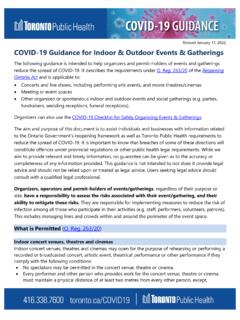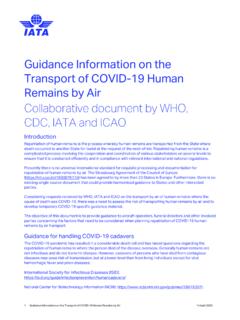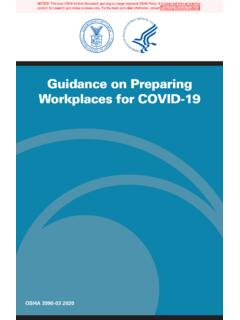Transcription of ESSENTIAL WORKFORCE - California
1 April 28, 2020 1 ESSENTIAL WORKFORCE On March 19, 2020, Governor Newsom issued Executive Order N-33-20 directing all residents immediately to heed current State public health directives to stay home, except as needed to maintain continuity of operations of ESSENTIAL critical infrastructure sectors and additional sectors as the State Public Health Officer may designate as critical to protect health and well-being of all Californians. In accordance with this order, the State Public Health Officer has designated the following list of ESSENTIAL Critical Infrastructure Workers to help state, local, tribal, and industry partners as they work to protect communities, while ensuring continuity of functions critical to public health and safety, as well as economic and national security.
2 Sector Index: 1. Health and Public Health Sector 2. Emergency services Sector 3. Food and Agriculture Sector 4. Energy Sector 5. Water and Wastewater Sector 6. Transportation and Logistics Sector 7. Communications and Information Technology Sector 8. Government Operations and Other Community-Based ESSENTIAL Functions 9. Critical Manufacturing Sector 10. Financial services Sector 11. Chemical Sector 12. Defense Industrial Base Sector 13. Industrial, Commercial, Residential and Sheltering Facilities and services Relevant Guidance For All Sectors: Face Coverings Guidance Orientaci n Sobre el Uso de Mascarillas de Tela Self-Isolation for Older Adults and Those Who Have Elevated Risk Aislamiento para Adultos Mayores y Personas que Tienen un Riesgo Elevado Employers, health care workers and workers in general industry April 28, 2020 2 1.
3 HEALTHCARE / PUBLIC HEALTH Sector Profile The Healthcare and Public Health (HPH) Sector is large, diverse, and open, spanning both the public and private sectors. It includes publicly accessible healthcare facilities, research centers, suppliers, manufacturers, and other physical assets and vast, complex public-private information technology systems required for care delivery and to support the rapid, secure transmission and storage of large amounts of HPH data. ESSENTIAL WORKFORCE , if remote working is not practical: 1. Health care providers and caregivers (including physicians, dentists, psychologists, mid-level practitioners, nurses, assistants, and aids; infection control and quality assurance personnel; pharmacists; physical, respiratory, speech and occupational therapists and assistants; social workers and providers serving individuals with disabilities including developmental disabilities; optometrists; speech pathologists; chiropractors; diagnostic and therapeutic technicians; and radiology technologists).
4 2. Workers required for effective clinical, command, infrastructure, support service, administrative, security and intelligence operations across the direct patient care and full healthcare and public health spectrum, including accounting, administrative, admitting and discharge, engineering, accrediting, certification, licensing, credentialing, epidemiological, source plasma and blood donation, food service, environmental services , housekeeping, medical records, information technology and operational technology, nutritionists, sanitarians; emergency medical services workers; prehospital workers including but not limited to urgent care workers; inpatient and hospital workers; outpatient care workers; home care workers; workers at long-term care facilities, residential and community-based providers; workplace safety workers).
5 3. Workers needed to support transportation to and from healthcare facilities and provider appointments. 4. Workers needed to provide laundry services , food services , reprocessing of medical equipment, and waste management. 5. Vendors and suppliers (including imaging, pharmacy, oxygen services , durable medical equipment) 6. Workers who perform critical clinical research, development, and testing needed for COVID-19 response. 7. Workers in other medical and life science facilities (including Ambulatory Health and Surgical, Blood Banks, Clinics, Community Mental Health, Comprehensive Outpatient rehabilitation, End Stage Renal Disease, Health Departments, Home Health care, Hospices, Hospitals, Long Term Care, Organ Pharmacies, Procurement Organizations, Psychiatric, Residential, Rural Health Clinics and Federally Qualified Health Centers, and retail facilities specializing in medical goods and supplies, including cannabis).
6 8. Workers for health manufacturing (including life science companies, and companies that have shifted production to medical supplies), materials and parts suppliers, technicians, logistics and warehouse operators, printers, packagers, and distributors of medical equipment (including those who test and repair), personal protective equipment (PPE), isolation barriers, medical April 28, 2020 3 gases, pharmaceuticals (including materials used in radioactive drugs, and cannabis products), dietary supplements, blood and blood products, vaccines, testing materials, laboratory supplies, cleaning, sanitizing, disinfecting or sterilization supplies, personal hygiene products, and tissue and paper towel products. 9. Public health / community health workers, including those who compile, model, analyze and communicate public health information.
7 10. Behavioral and mental health workers responsible for coordination, outreach, engagement, and treatment to individuals in need of mental health and/or behavioral services . 11. Donors of blood bone marrow, blood stem cell, or plasma and the workers of the organizations that operate and manage related activities. 12. Workers that manage health plans, billing, and health information. 13. Workers who conduct community-based public health functions, conducting epidemiologic surveillance, compiling, analyzing and communicating public health information. 14. Workers performing IT and cybersecurity functions at healthcare and public health facilities. 15. Workers performing security, incident management, and emergency operations functions at or on behalf of healthcare entities including healthcare coalitions.
8 16. Pharmacy employees, including workers necessary to maintain uninterrupted prescription filling. 17. Workers in retail facilities specializing in medical goods and supplies. 18. Public health and environmental health workers, including workers specializing in environmental health that focus on implementing environmental controls, sanitary and infection control interventions, healthcare facility safety and emergency preparedness planning, engineered work practices, and developing guidance and protocols for appropriate PPE to prevent COVID-19 disease transmission; Public health/ community health workers (including call center workers) who conduct community- based public health functions, conducting epidemiologic surveillance and compiling, analyzing, and communicating public health information.
9 19. Mortuary services providers, including workers performing mortuary, funeral , cremation burial, cemetery, and related services , including funeral homes, crematoriums, cemetery workers and coffin makers. 20. Workers who coordinate with other organizations to ensure the proper recovery, handling, identification, transportation, tracking, storage, and disposal of human remains and personal effects; certify cause of death; and facilitate access to behavioral and mental health services to the family members, responders, and survivors of an incident. 21. Workers supporting veterinary hospitals and clinics. Relevant Sector Guidance: All Facility Letters for health care facilities, including long-term care facilities Health care facilities, Skilled Nursing Facilities Individuals with Access and Functional Needs Medical Waste Management - Interim Guidelines Outpatient Healthcare Facility Infection Control Recommendations for Suspect COVID-19 Patients Prioritization of Patients for Laboratory Testing for COVID-19 Veterinary Professionals and Premises Regional Centers.
10 Visits to Licensed Residential Facilities Risk Mitigation Strategies for ARFPSHN, ICF/DD-CN Adult and Senior Care Facilities April 28, 2020 4 Cuidado a los Adultos Mayores Community care facilities, including assisted living facilities and child care Medi-Cal Managed Care Health Plans: COVID 19 Screening and Testing Coverage Options Fact Sheet Opciones De Cobertura Department of Managed Health Care All Plan Letter California Department of Insurance Bulletin April 28, 2020 5 2. EMERGENCY services SECTOR Sector Profile The Emergency services Sector (ESS) is a community of highly-skilled, trained personnel, along with the physical and cyber resources, that provide a wide range of prevention, preparedness, response, and recovery services during both day-to-day operations and incident response.








